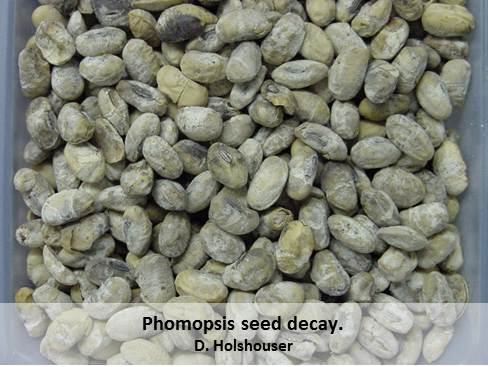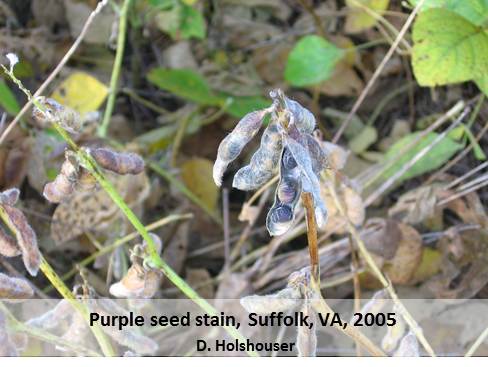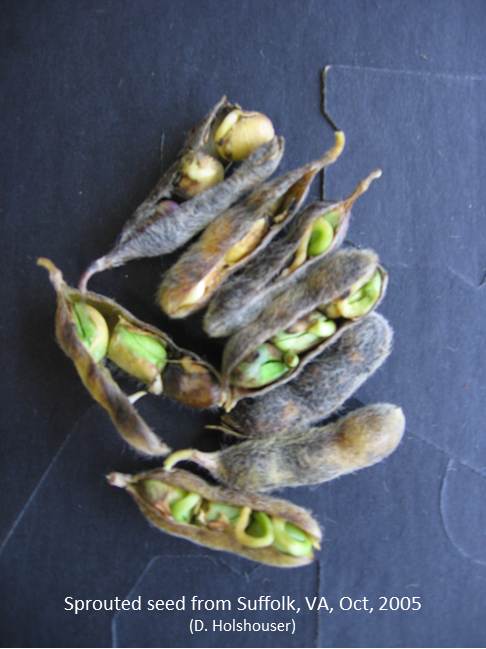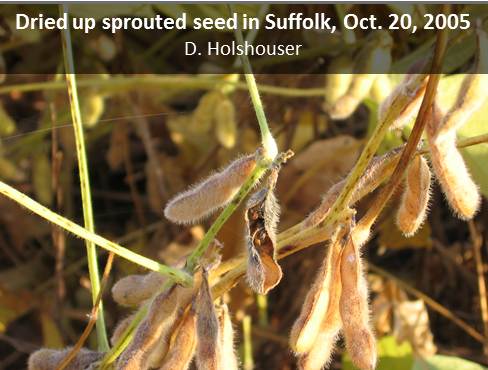We gained much needed rain in late August with Hurricane Irene. It also brought substantial lodging, which reduced our yield potential. But, I have yet to see a poor soybean crop lodge. That August rain by itself would have pretty much finished out our full-season crop; our full-season soybean may not benefit much from the continued rain that we are still experiencing. However, the double-crop plantings still had lots of yield to make; therefore, the September rains helped fill out that crop.
Any yield increases with September rains will come mainly in the form of greater seed size. So, how important are larger seed? Although number of seeds (mainly through number of pods) affect soybean yield most, seed size is second in importance. The photo below may help illustrate this point.
In the above example, the weight of the larger seed is more than 50% greater than the small seed. Of course these differences resulted from two extremely different environments. The seed to the left of the pencil formed under late-season drought conditions. The seed to the right of the pencil was produced under excellent seed fill environment, similar to this year. If we were to assume that there were an equal number of seed and pods in both cases, the crop with the larger seed would have resulted in about 10 bushels more yield in a 20 bushel environment, 15 bushels more in a 30 bushel environment, and so on. Don’t misunderstand. Plants with lots of seed and pods will not make very big seed. We won’t get that much of a yield increase from this year’s late-August and September rains. A large yield increase would have only resulted if we were to compare to a crop where little to no rain occurred during the seed-fill period. Still, these late-season rains should definitely add 10-20% to our overall yields.
Now for the bad news – with these September rains comes an increase in disease affecting seed quality. Furthermore, with heavy October rains, there is the possibility of pod splitting or seed sprouting in the pods before harvest. This does not happen often, but years like this one will set the crop up for such a scenario. In the remainder of this article, I’ll focus on the most common seed quality issues.
Phomopsis Seed Decay. When soybeans mature during warm and wet conditions, we can expect seed quality to deteriorate. Because this disease develops more rapidly on plants that are maturing under warm and wet conditions, we usually have more problems with early-maturing varieties. We can however have seed decay on our later- maturing varieties if October is warm.
Infected seed are shriveled, elongated, and c racked. Severely infected seed may appear white and chalky. Test weight can be lower. High occurrence of these seed can lead to discounts or rejection.
racked. Severely infected seed may appear white and chalky. Test weight can be lower. High occurrence of these seed can lead to discounts or rejection.
There are a few things that can be done to reduce the disease incidence. It resides in the soil and on infected residue. So, rotation is very important. Later-maturing varieties and later planting dates that delay maturity into the cooler parts of the year will reduce the incidence. Still, timely harvest is the best management strategy. The longer you leave the soybeans in the field, the worse the disease. So, only plant as many early varieties as you can harvest in a timely manner. Foliar fungicides will decrease the incidence of seed decay if applied from mid pod development to early seed filling stages (R3-R5).
Purple Seed Stain. Purple seed stain is caused by the organism Cercospora kikuchii, the same organism that causes Cercospora blight. Although little of this disease was present early in the year, its incidence has increased dramatically since late-August. Right now, fields with Cercospora blight can usually be recognized by reddish leaves and reddish purple blotches on the stem and leaf petioles. When severe, defoliation of the upper leaves of the plant will take place. In many cases, the blotching progressed up the stem and to the pods. In the pas t, you may have noticed the dark, nearly black pods on some varieties. Once it progresses to the pods, there is a higher likelihood that the seed will be stained.
t, you may have noticed the dark, nearly black pods on some varieties. Once it progresses to the pods, there is a higher likelihood that the seed will be stained.
Purple seed stain is very noticeable. The seed will contain pink to pale purple to dark purple splotches, which can cover the entire seed coat. The purple stain itself does not reduce yield, but seed with nearly 100% discoloration may be lower in oil and higher in protein. A lot of staining can result in discounts. Germination of seed with 50% or more staining will likely be delayed. This year, our insect scout, Mr. Ed Seymore, is already noticing dark pods and some purple seed stain.
Usually, the disease first appears on the plant during early seed development. If conditions are right (average temperatures over 80o for several days), then the disease will build up rapidly. We had those conditions this year. Other weather factors do not generally affect seed  infection. Severity of the infection is largely related to amount of infected leaf debris and residue. Therefore, rotation with a non-legume crop is critical for control.
infection. Severity of the infection is largely related to amount of infected leaf debris and residue. Therefore, rotation with a non-legume crop is critical for control.
Other control measures include variety selection, planting high quality seed free of visual staining, and fungicides. Varieties differ in their susceptibility of Cercospora kikuchii, but that information is rarely available in seed catalogs. We routinely evaluate purple seed stain in our variety tests. Strobilurin fungicides such as Quadris or Headline seem to give some control if applied during pod or seed formation.
Sprouting Seed. One of the most disturbing late-season issues can be pod splitting or seed sprouting in the pod. Back in 2005, we saw a lot of this. That year was very dry up until September and October, when it began raining and didn’t seem to want to quit. What causes pod splitting? The verdict is still out on this, but  here are my observations. Generally this happens when the crop is under severe stress, usually drought conditions up until the full-seed stage (R6). Pods are generally small due to the drought. Then rains set in between R6, and R7 (Physiological maturity). The seed grow and grow, and seem to outgrow the pods, causing them to split. Obviously, this splitting can then lead to seed quality issues.
here are my observations. Generally this happens when the crop is under severe stress, usually drought conditions up until the full-seed stage (R6). Pods are generally small due to the drought. Then rains set in between R6, and R7 (Physiological maturity). The seed grow and grow, and seem to outgrow the pods, causing them to split. Obviously, this splitting can then lead to seed quality issues.
In 2005, not only were the some pods splitting, but October rains brought on sprouting seed. The sprouting seed was not always directly related to the pod splitting; many of the pods in which we found sprouting seed were did not split until the seed sprouted. We saw up to 30% of the pods with sprouted seed in some locations. This is a very unusual occurrence, but can occur if soybean seed drop below 50% moisture, then increase to 50% or more moisture. We immediately began looking in other fields and contacting county agents to do the same. Soon after our discovery, I heard of reports from North Carolina of sprouting and reports from Pennsylvania of seed swelling in the pod. However, after getting several reports back from county agents and farmers, and after we checked several other fields, we found that the problem was not nearly as severe as in our fungicide trial or as widespread as we may have thought. Below is a summary of our findings:
- The sprouting problem was worse in southeastern Virginia. Although we had reports as far north as Essex County, the incidence of sprouting seed declined as we moved north and west.
- More sprouting was occurring on the later-planted, later-maturing varieties. This was verified in our variety test and by several county agents.
- More sprouting was occurring in pods showing Cercospora blight (very dark pods). This was verified in a fungicide trial, our variety test, and by several agents. We did not understand why this happened and could not definitely relate the sprouting to this disease. But, there seemed to be a relationship.
- Sprouting occurred primarily at the top of the plant when dark pods (also occurring primarily at the top of the plant) were common. Otherwise, most sprouting (especially that occurring on earlier-planted, earlier-maturing varieties) occurred at the bottom of the plant where the relative humidity was higher.
- After a week of drying conditions, the sprouted seed had dried up, and in some cases fallen out of the pods.
 Why did the seed sprouting occur on the later-planted, later-maturing varieties in 2005? There are two or three possible explanations. One is that these varieties may have just dropped below 50% moisture; therefore the seed needed to absorb less total moisture to raise it back above 50%. A second explanation is that these varieties still had significant amount of leaves, therefore held the moisture within the soybean canopy better. Finally, in 2005, there was more Cercospora in the later-planted later-maturing varieties (note: Cercospora is not always worse in one maturity group or another, but depends on the environment during early seed fill).
Why did the seed sprouting occur on the later-planted, later-maturing varieties in 2005? There are two or three possible explanations. One is that these varieties may have just dropped below 50% moisture; therefore the seed needed to absorb less total moisture to raise it back above 50%. A second explanation is that these varieties still had significant amount of leaves, therefore held the moisture within the soybean canopy better. Finally, in 2005, there was more Cercospora in the later-planted later-maturing varieties (note: Cercospora is not always worse in one maturity group or another, but depends on the environment during early seed fill).
So, will we see pod splitting or seed sprouting in 2011? I would expect some pod splitting from fields under drought stress during the summer followed by lots of September rain. But, usually, the number of split pods is low and will not affect overall yield or quality substantially. If seed sprouting occurs, the problem will not likely be widespread and should not affect our overall seed quality very much. At the worst, there could be some lower test weight and seed could contain more foreign material (from the dried up sprouts). However, the light seed will likely be blown out the back of the combine. If you do observe the problem and it is severe, I suggest that the air on the combine be adjusted to remove those light, sprouted seed at harvest. Too many sprouted seed in the bin could lead to rejection by the buyer.


